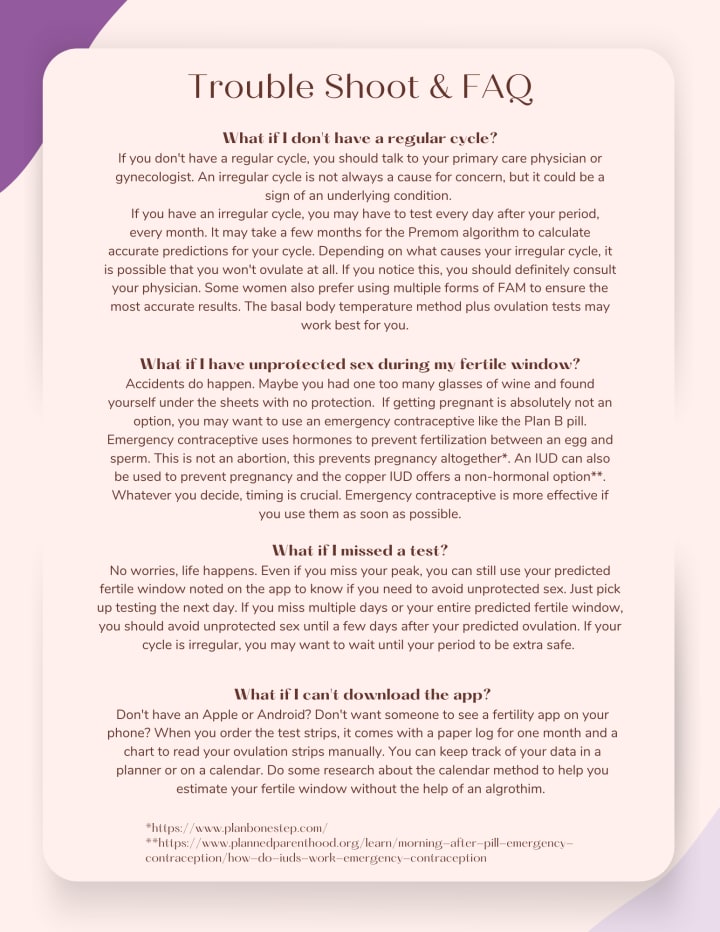Is There an Effective & Hormone-Free Birth Control?
The short answer is, YES! We all know someone who has suffered at the hands of hormonal birth control. We’ve been told since we were teenagers that this was a fact of life. But what if I told you there was a better way?

This is for educational purposes only and is not intended to replace the advice of your doctor or other health care provider. Please discuss any questions or concerns you may have with your provider. The birth control discussed below does not protect against STDs or STIs.

(Don't care for all the hoopla? Scroll to "Is there a better way to do the Fertility Awareness Method?" for the nitty gritty.)
When I was 18 years old, I was told that I had a genetic mutation that would increase my chances of developing breast cancer. The type of cancer that runs in my family feeds off of progesterone and estrogen, which just happens to be the building blocks of hormonal birth control. So they advised me to avoid it all together. At the time, it wasn’t a huge concern, but I realized that one day it would be and my options would be limited.
I started researching every form of birth control, its side effects, and its effectiveness. The deeper I looked, the more unsettling my findings became. I found story after story of women talking about how hormonal birth control affected their mental health, changed their bodies, and made them sick. A girl I worked with told me she threw up every morning, every single morning since she started taking the pill. When I asked her why she was still on it, she said she didn’t feel like she had another option. My heart broke. Unfortunately, she wasn’t the only person I knew who experienced awful side effects from birth control, and it’s not just the pill causing problems.
There had to be a better way. Not just for women like me, who felt like they had to choose between increasing their risk for breast cancer or getting pregnant, but for women who hate the side effects of hormonal birth control. The only alternative that I saw available was the copper IUD… You know, the one with side effects including pelvic inflammatory disease (PID), embedment, uterine perforation, and more (1)… Even if those side effects are relatively rare, it’s still the stuff of nightmares.
But as I kept digging into alternative forms of birth control (BC), I found the Fertility Awareness Method. A hormone-free option that seemed too good to be true...
What is Fertility Awareness Method (FAM)?
Fertility Awareness Method aka Natural Family Planning aka Rhythm Planning. All of that is just a fancy way of saying, you track your cycle to determine your fertile window and use that information to prevent pregnancy.
What is a Fertile Window?
Did you know you can only get pregnant for about a week each month? Sperm can live for about 5 days in the fallopian tubes, and your egg is only viable for about 24 hours. These six days are called your fertile window. FAM is all about identifying when you’re in your fertile window, so you avoid having unprotected sex, thus preventing pregnancy.
There are a few different ways to go about finding your fertile window, but what if I told you, I’ve tried the three most common options, and I didn’t trust any of them…
Calendar Method: Track your menstrual cycle and calculate the estimated fertility window using your average cycle length, or use a period tracking app that uses an algorithm to calculate your estimated fertility window.
- Your cycle isn’t the same every month, at least mine isn’t. There can be variability in your cycle length. So if my app couldn’t predict the start date of my period every single month, how could it accurately predict my fertile window?
- You have to put all your trust in the algorithm of an app that isn’t designed to be used as birth control… considering having a child is life-altering, that’s not a gamble I was comfortable with.
Basal Body Temperature Method: By checking your temperature every morning when you first wake up, you can identify a pattern that will show your basal body temperature rising and falling at different phases of your cycle.
- You’re supposed to get so many hours of sleep each night and wake up at the same time every morning to get the most accurate results. As someone who has chronic insomnia and is terrible at maintaining routines, you can see where I could have some issues keeping up with this.
- Most period tracking apps can’t calculate your fertility window with that data, so you would still have to graph the temperatures manually to figure out when you’ve ovulated. Or you have to use an app like Natural Cycles which costs a whopping $99 (which is a big investment for something that might not work for you).
- This is relativity minor, but the underside of my tongue was constantly sore from using the thermometer, which was annoying.
Cervical Mucus Method: Your cervical mucus changes in color and consistency depending on where you are in your cycle. Tracking your cervical mucus can help identify where or not you’re fertile.
- Multiple things such as dehydration, diet, infections, and more can affect cervical mucus.
- You’re supposed to check your mucus every time you go to the bathroom for the most accurate results. Every. Single. Time. I don’t know about you, but when I’m running around like a madwoman at work and I have barely any time to do my business, remembering to look at what’s going on downstairs is not a priority.
Many women use multiple methods at the same time to ensure the most accurate fertile window. There are hundreds of blogs, websites, classes, and books that can teach you how to do each of these methods. Some women will swear by one or the other. I, on the other hand, did not feel comfortable using any of those methods as my main form of birth control.
Is there a better way to do the Fertility Awareness Method?
After months of failed experimentation, I decided to try a different approach. I began researching how women with fertility issues try to conceive using FAM. My thinking was if there was an accurate way for women to identify their fertile window to get pregnant, then I could do that same process to avoid getting pregnant. That’s when I found ovulation tests and an app that helps you get pregnant.
Now hear me out. Premom (not sponsored) is an app that uses ovulation tests to help women get pregnant. In fact, they’re so confident in their algorithm and test strips they offer a money-back guarantee if you don’t get pregnant in 9 months. If they’re that confident in helping women identify their fertile window to conceive, why can’t I use that same information to prevent pregnancy?

What are ovulation tests?
Ovulation tests work by identifying the Luteinizing Hormone (LH) in your urine. As you get closer to releasing an egg, your LH levels rise. Once your levels drop back down, that means you’ve ovulated aka the egg was released.
Not only does Premom use ovulation tests, but it uses quantitative tests instead of qualitative. Qualitative ovulation tests give you a positive or negative result, identifying whether or not LH is present. Quantitive ovulation tests give you a numerical value that tells you how much luteinizing hormone is present. The reason that is so important is that you can see exactly what is going on in your body. There’s no guesswork involved. This method doesn’t rely on an algorithm. Instead, it uses data that you can see with your own eyes, which brought me a lot of comfort and seemed to be a more accurate option.
How do I do this method?
First, let's get set up!
You can download the free Premom app on the iPhone or Android. They offer a subscription, but you don’t need it.
You will need to buy ovulation tests. The Premom app is compatible with Premom and Easy@Home test strips. I’ve only used the Premom brand. You can buy these tests on their website or on Amazon. I also use 3 oz paper cups to collect my “sample,” if you catch my drift.

Next, make it convenient!
Making it convenient is the best way to make FAM work for you. Set up reminders on the Premom app to remind you every day you’re supposed to take a test. It’s best to test around the same time if possible. I set my alarm to go off when I normally get home from work because I usually need to use the bathroom, anyway. But don’t worry if you normally test at 6 pm and then you realize it’s 8 pm and you still haven’t tested. This is a very forgiving method. Also, keep your tests handy! I have a little box that holds my feminine products and my testing supplies that sits on the back of my toilet. I also have a little bag that I take with me that fits perfectly in my backpack, suitcase, and purse.

Once you're all set up, it's time to start tracking.
It’s crucial that you track the start and finish date of your period. This helps the algorithm accurately estimate your fertile window. If you already know you don’t have a regular cycle, don’t worry, you can still use FAM with a few tweaks (see FAQ).
You may also want to track your sexual activity. This is helpful if your period is late, which can cause some anxiety (a little variability in your cycle is completely normal). You can look and see that you didn’t have unprotected sex when you were fertile therefore, you can’t be pregnant.

In the beginning, it’s recommended you start testing as soon as your period is over. Some women can ovulate shortly after their period, so it’s better to be safe than sorry. Once you know your cycle length, you can start testing two days before your projected fertile window.
Two to three days before you are predicted to ovulate, you should test twice a day. At lunch and again in the evening. This is because some women’s LH levels peak and drop within 12 hours. To be honest, after a few cycles I realized my peak took 24 hours so I only test once a day. There are a few different types of peaks, so don’t worry if your LH levels fluctuate.

Once your LH drops, that means you’ve ovulated. Mark that you’ve ovulated on the app and keep testing for another two days to ensure that your LH levels stay down.
During your predicted fertile window, you’ll have to use a secondary form of birth control like condoms or avoid having sex altogether. I recommend avoiding unprotected sex two days before your predicted fertile window until two days after you ovulate.

And that’s it! 48 hours after you ovulate, you can start having unprotected sex again and you can continue to enjoy your hormone-free birth control. The cool thing about FAM is it only affects your life for about 10 days. Gone are the days of taking a pill every day, checking to see if your patch is still on, or taking your temperature every morning.
How effective is this?
According to ashasexualhealth.org, FAM is 76% effective at avoiding pregnancy with typical use. That means, that 24 out of every 100 women get pregnant while using FAM. However, that calculation is based on the Calendar Method, the Basal Body Temperature Method , and the Cervical Mucus Method.
Two factors determine how effective this version of the Fertility Awareness Method is: your cautiousness and consistency. Cautiousness is what birth control you use during your fertile window. If you don’t have sex, there is a 100% you can’t get pregnant, if you rely on the pull-out method then there is a 78% you won’t get pregnant, and if you use a condom, then there is an 84% chance you won’t get pregnant(2). Consistency is based on if you test when you’re supposed to test. This ensures you accurately identify your fertile window. In short, you determine how effective FAM is.
I’ve now been using this form of FAM for over a year and guess what? We’re still baby free!
I’m not saying there weren’t any issues. There was a lot of anxiety, especially at the beginning. In all my research, I could never find a statistic for this form of FAM, which meant I didn’t know how effective it was going to be. But I knew the science was there, so I took the leap of faith and I’m so glad that I did.
Honestly, this is my soapbox. This is something I'm so incredibly passionate about. There are women who don't have negative side effects from hormonal BC, but for those who experience, weight gain, acne, and mood swings (to list a few), there is another option. You no longer have to choose between being miserable or getting pregnant. You have every right to live a healthy life, without the fear of pregnancy.
Have a question? Feel free to email me at [email protected] or drop a comment below.

(1) https://www.paragard.com/wp-content/uploads/resources/paragard-patient-factsheet-english.pdf
(2) https://www.ashasexualhealth.org/pdfs/ContraceptiveOptions.pdf
About the Creator
K’Lee P.
K'Lee has a love for storytelling, psychology, and adventure.






Comments
There are no comments for this story
Be the first to respond and start the conversation.